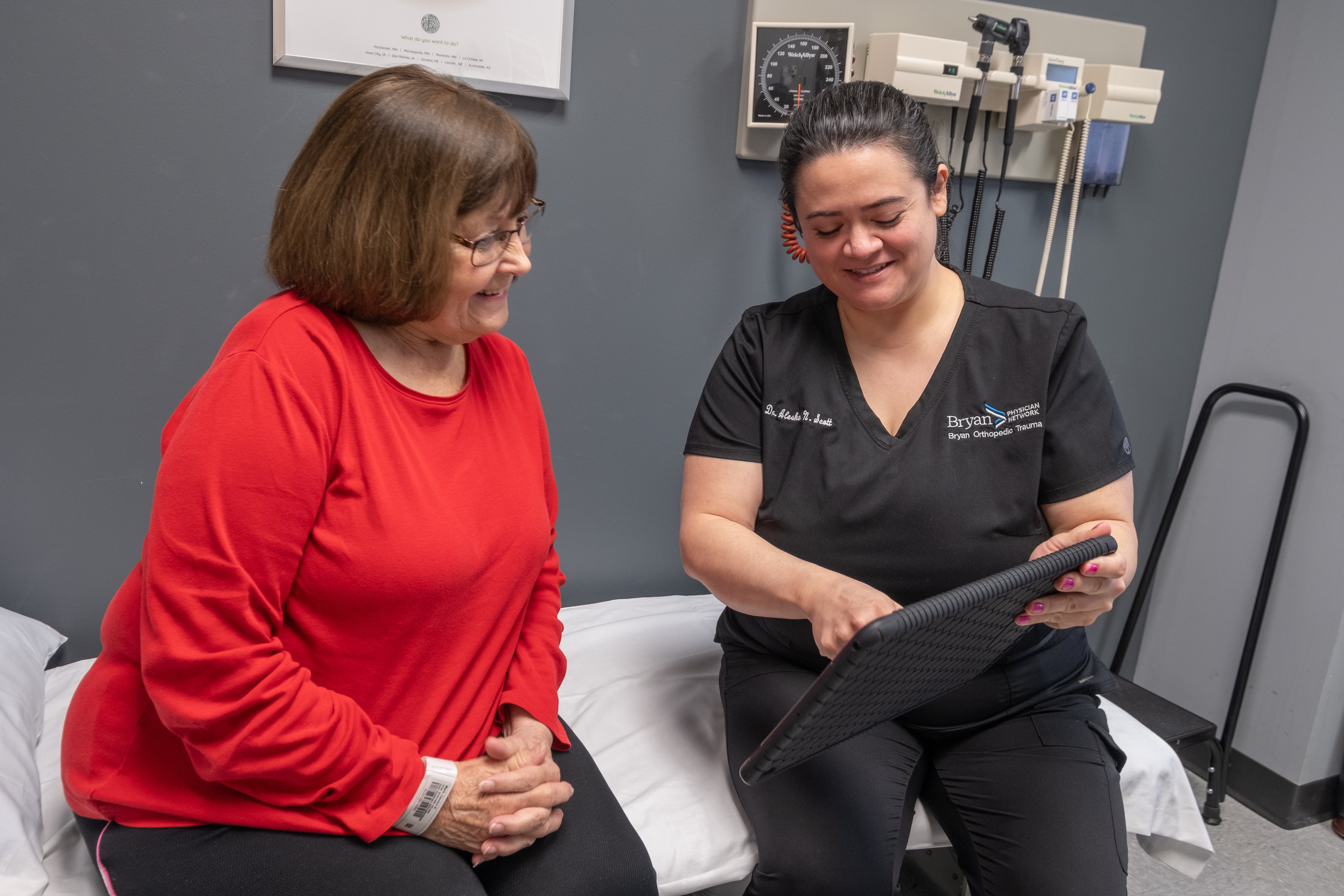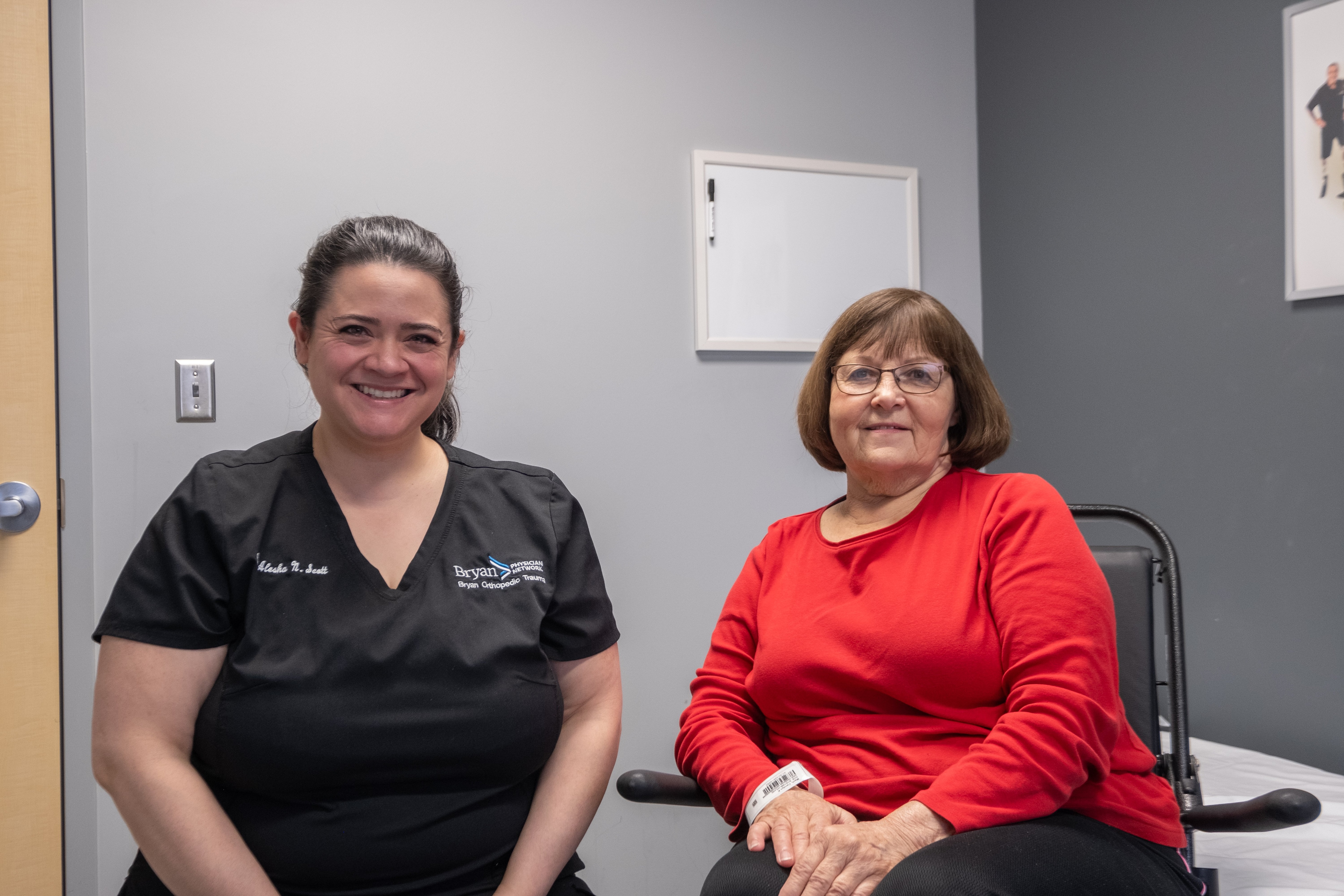Carolyn Has a Swift Recovery After Broken Pelvis, Innovative Procedure
Carolyn Mach knew something was wrong immediately after the fall. The pain in her lower torso was debilitating, and she couldn’t get herself off the ground.
ER doctors at Crete Area Medical Center performed an X-ray, discovering a fracture in Mach’s pelvis. She was kept overnight for observation as a precaution; the next day, her blood pressure began to drop.
CAMC doctors called Dr. Alesha Scott, medical director of orthopedic trauma at Bryan Medical Center, who recommended a CT scan. Soon after, Mach was in an ambulance on her way to Lincoln, with surgery scheduled for the next day.
The CT scan determined that Mach did indeed have a pelvic ring injury with multiple fractures, two in the front and one in the back. Dr. Scott, who was recruited by Bryan Health in 2017 to build the orthopedic trauma program, said it’s common for the pelvis to break in multiple areas due to its rigid nature. The break in the back of the pelvis is why the injury hurt too much for Mach to walk on it.

An Innovative Solution
Dr. Scott operated on Mach in January through percutaneous – or very small – incisions in the skin. The surgeon uses wires and a live X-ray machine to tunnel through safe corridors in the bone and insert screws to stabilize the bones. The process is minimally invasive and has a much shorter recovery time compared to an “open” procedure.
Dr. Scott learned the procedure through her orthopedic trauma fellowship at the University of Kentucky and has performed it “more times than I can count.” She was the first orthopedic surgeon to bring fully percutaneous pelvic fixation to Lincoln.
Before bringing this surgery to Lincoln, patients with this type of injury had limited treatment options. There is too much pain to move or do physical therapy. This meant weeks of bed rest while trying to manage the pain, as it takes at least six weeks for the bone to heal. For many older adults, this becomes an injury from which they are not able to recover; it can be a death sentence.
With this specialized surgery, patients get their life back, Dr. Scott said. They have significantly reduced pain and can participate in physical therapy and other activities to regain strength and mobility.
Swift Recovery
Mach said she was relieved to learn she was going to have surgery instead of multiple weeks in bed.
“I just thought, it’s got to be better than the way I was,” she said with a laugh. “And it was, I mean, it was a night and day difference after the surgery.
“I was in surgery, and then Dr. Scott came in and said, ‘Can you imagine not having the surgery?’ And I said ‘no.’ Everything was great. They did well by me.”
Mach said she had a compassionate experience under Dr. Scott and her team’s care.
“Everything went smoothly,” Mach said. “They took care of me. I was amazed by Bryan's emergency room, how all these people were doing their jobs so fast, getting me taken care of.”
Mach, a lifelong Nebraskan, was walking with the assistance of a physical therapist and a walker the same day as her surgery. She was able to go right home with her husband of 53 years, Dean, and has continued with outpatient physical therapy twice a week at CAMC. A few weeks after the surgery, Mach attended her son’s wedding. She is positive she would not have been able to be there without the successful surgery.
Though she’s still in some pain, she said it’s far more bearable than before the surgery, and that she has steadily made progress ever since.
“I’m still going with the walker, but it’s getting better,” Mach said. “Every day it’s a little easier.”

Warning Signs
Dr. Scott said she most often sees pelvic fractures like Mach’s in older patients who have lower bone density to begin with and may also have osteoporosis. Such patients also are more likely to have undiagnosed injuries. Pelvic fractures in younger patients come from more obvious injuries, like a car accident or a fall from a ladder, Dr. Scott said, whereas older patients may seriously hurt themselves without even knowing.
“The patients who can fall through the cracks are those who just slip and fall, or maybe even slip off of their recliner and bump their hip and think it's nothing, and then it just doesn't feel better,” she said.
Dr. Scott provided some warning signs for patients who have had a recent fall. Hip, groin, lower back and pelvis pain is common after a minor fall and may go away after a day or two, she said. However, if they’re not able to take a step or sit without pain, they should go see their doctor and get an X-ray. If an X-ray doesn’t show a break and they’re still in major discomfort, Dr. Scott said they can come to her office for a CT scan or MRI.
Mach said she hopes her story helps others with similar traumatic injuries, as she encourages people to be aware that this treatment option exists in Nebraska.
“Do it,” Mach said. “Definitely do it. It’ll get you going faster, and you’ll be on the mend sooner. You hear people not having this surgery, and a lot of them die. I feel fortunate that they were able to do this for me.”
To subscribe to Journeys or read more stories like this one, click here.
To learn how you can support the work of Bryan Health, please contact the Bryan Foundation staff by calling 402-481-8605.

